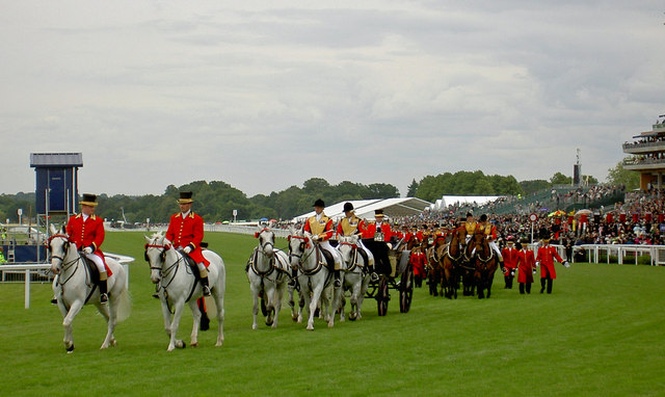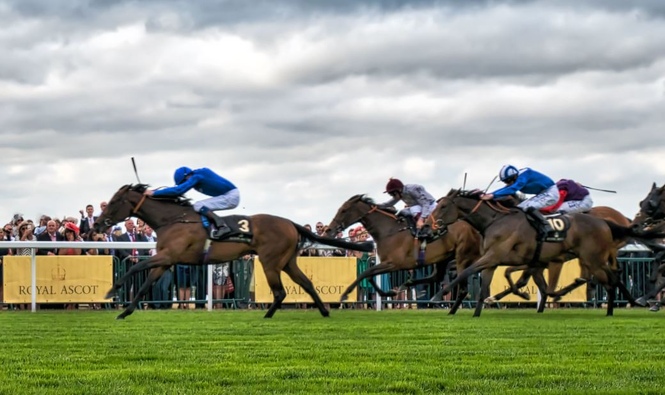Royal Ascot
Just as the four days of the Cheltenham Festival in March mark the pinnacle of the National Hunt racing season, the five days in June that see Ascot stage its Royal Ascot meeting represent the highlight of the Flat racing year.
Here we take a look at the history of the meeting, as well as providing information on the festival day by day and race by race.
Royal Ascot Overview
There may be more prestigious races run throughout the calendar but in terms of sustained quality there is little to compare to this Flat festival. The standard on offer is well illustrated by the fact that of the 32 British Group 1 races run each year, eight are at this meeting. As if that wasn’t enough there are 10 additional Group contests over the five days.
Located just six miles from Windsor Castle both the Ascot course and this Royal meeting were founded by Queen Anne in 1711. This Royal tradition continues to the present over five days filled with pomp and occasion. A Royal procession provides a dramatic prelude to each of the days’ racing, with the Queen and other dignitaries in attendance throughout the week. This unique prestige has helped Royal Ascot grow to become Europe’s best attended race meeting. Almost as much a showcase for the latest fashions, and hats in particular, as it is for the racing, it has become one of the social events of the British year.
We prefer to concentrate on the equine talent on display of course, and what talent there is. Attracted by total prize money of £5.5million, the meeting draws the cream of the crop from across Europe and further afield. Expect to see the superstar older horses mixing it with the best of the current Classic generation. Here we take a look at the major races of the week with particular focus on the Group One contests.
Ascot Day One

Queen Anne Stakes
It is fitting that the first Group One event of the week is named in honour of the monarch who founded the meeting way back in the 18th century. The Queen Anne Stakes has been a feature of the Royal Ascot offering since 1840 and has risen in prestige over the years, culminating in it being granted Group 1 Status in 2003. The conditions of the race were also changed in this year, making it open only to horses aged four or over. No trainer or owner has taken this mile contest more times than Saeed Bin Suroor and Godolphin who won the Queen Anne Stakes on seven occasions between 1996 and 2007. The incomparable Frankel recorded one of the most impressive of his 14 career wins in this race in 2012.
King’s Stand Stakes
The sprinters take centre stage in the second Group 1 contest (after the Group 2 Coventry Stakes whets our appetite) in this 5f event open to thoroughbreds aged three and older. Having been run in one guise or another since 1860, the origins of one of the top sprint races in Europe owes much to the vagaries of the English weather. The Royal Stand Stakes was a marathon two mile contest but due to torrential rain in 1860, only 5f of the track was deemed race-able. The race was reduced to this 5f distance and the rest is history. Repeat winners of the King’s Stand Stakes have been a regular feature of this event with 11 horses managing to land the prize twice.
St James’s Palace Stakes
The third and final Group 1 contest of a spectacular opening day is the 1 mile St James’s Palace Stakes event restricted to the Classic generation of colts. A truly mouth-watering affair it often sees the principles from the English, Irish and French 2000 Guineas locking horns. Given some of the winners of the race and the regard in which it is held, it is perhaps surprising it took until 1988 to be granted Group 1 status. The brilliant Brigadier Gerrard, Rock Of Gibraltar and Frankel feature on the list of previous winners.
Day Two

Prince Of Wales’s Stakes
Just the one Group 1 contest on day two of Royal Ascot but the Prince of Wales’s Stakes is a cracker that’s for sure. Granted its top tier status in 2000, this event for four-year-olds and up is one of the premier 1m2f contests of the racing year. Originally run over 1m5f in 1862, the current distance was adopted in 1968. The race has been won by the greatest Godolphin horse of them all, the ill-fated Dubai Millennium and one of the best fillies of the early 21st Century Ouija Board. Along with the Diamond Jubilee Stakes on the concluding day this race has historically been the most valuable in terms of prize money of the whole meeting.
Duke Of Cambridge Stakes
One of the newer races at the meeting having only been introduced in 2004, the one mile Duke Of Cambridge Stakes is restricted to fillies and mares aged four years and older. Sir Michael Stoute has been the dominant trainer in the race to date with four wins in the first 11 editions of the race so his horses are always worth considering in the betting.
Royal Hunt Cup
Fans of big field handicaps aren’t left out over the course of the meeting, with this one mile contest run on the straight course being the pick. A handicap rich in heritage having been run since 1843 it remains a much sought after prize. Whilst it might not always be easy to find the winner, there’s usually plenty of each way value in the betting, with plenty of high odds winners in the past.
Ascot Day Three

Norfolk Stakes
This event gives the youngsters their chance to shine. Granted Group 2 status in 2006, the Norfolk Stakes is a contest for two-years-olds and is run over the minimum 5f trip. Lester Piggott demonstrated his sprint race mastery in taking this race nine times over a 31 year period.
Ribblesdale Stakes
This Group 2 is restricted to three-year-old fillies and is run over the Oaks trip of 1m4f. As such the Ribblesdale Stakes attracts fillies that have run in the Epsom Classic with runners often going on to compete in the Irish Oaks. Frankie Dettori has proven particularly effective in this race with six wins between 1995 and 2010 so keep an eye on the odds of whatever he’s riding.
Gold Cup
Part of British flat racing’s triple-crown for stayers, this 2m4f test of endurance is the race connections of the top long distance horses all want to win. Aiden O’Brien won the Ascot Gold Cup six times between the years of 2006 and 2014 largely thanks to the exploits of Yeats, whose four consecutive victories between 2006 and 2009 mark him out as perhaps the greatest stayer of them all. The longevity of the older staying horses results in many repeat attempts at this race enabling horses to garner a place in the public affections. A new Gold Cup is created each year in order that owners may keep this special prize.
Day Four

The King Edward VII Stakes
The original title of this race gives a clue to its conditions. Originally known as the Ascot Derby, the King Edward VII Stakes is a Group 2 contest is for three-year-old colts and geldings and is run over a trip of 1m4f. Not as prestigious as the Epsom Classic it does attract some runners to have taken part in that early June event and is always a fascinating betting opportunity.
Coronation Stakes
Established in 1840 to honour the coronation of Queen Victoria, the Coronation Stakes is the fillies’ version of the St James’s Palace Stakes. Also elevated to Group 1 status in 1988 it regularly attracts runners from the English, Irish and French 1000 Guineas. Other than the fillies’ Classics this race is prized over any other, not just due to the prize money on offer but also the significant increase in breeding value bestowed upon the winner. Crimplene, Russian Ryhthm and Ghanaati are just three of the classy winners in the race’s history.
Commonwealth Cup
2015 sees a new Group 1 race added to the Royal Ascot menu with the Commonwealth Cup, a 6 furlong sprint restricted to three-year-olds. Previously the top young sprinters would have aimed to conquer their elders in the Diamond Jubilee Stakes but this is no longer an option with the latter race being restricted to four-year-olds and over from 2015. Three-year-olds have a decent record in the Diamond Jubilee but this is nevertheless a welcome addition to the top level sprinting calendar.
Royal Ascot Day Five

Hardwicke Stakes
The Hardwicke Stakes is a Group 2 contest that is a useful trial for the coveted King George VI and Queen Elizabeth Stakes which is run at the track in July. Many trainers have sent some pretty smart performers to this race over the years, not least Sir Michael Stoute who saddled the winner eight times between the years of 1986 and 2014 – keep your eyes on the odds of his runners if you fancy a bet!
Diamond Jubilee Stakes
The eighth and final Group 1 of a fabulous week at Royal Ascot is the Diamond Jubilee Stakes, a fabulously exciting six furlong event. 2015 sees a change in the conditions of this race which has been run at the track since 1868. Run as an all aged contest throughout its history, the three-year-olds are no longer permitted to enter as they now have the Commonwealth Cup to contest. Formerly known as first the Cork and Orrery and then the Golden Jubilee, it gained its current moniker in 2012 to celebrate the Diamond Jubilee of Queen Elizabeth II. Choisir completed a famous Royal Ascot double in this race in 2003, whilst fellow Australian Black Caviar took this prize during her 25-race unbeaten career. Lester Piggott won this race an incredible nine times.
Wokingham Stakes
Now over 200 years old this handicap event, the Wokingham Stakes is another six furlong dash and is named after a local market town and has always been a popular target amongst trainers eager to achieve a winner at the Royal Ascot Festival. The handicap nature of the race levels the playing field somewhat between the bigger and smaller yards with many horses being specifically targeted at this race.

